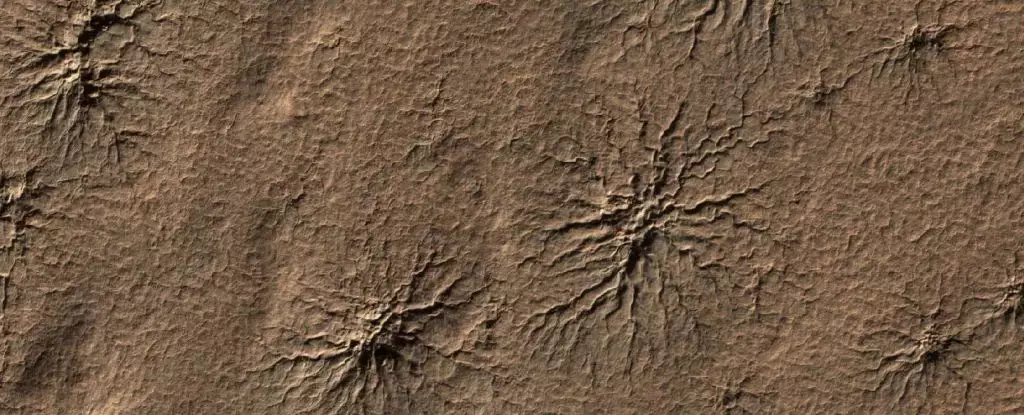Mars has often captured the human imagination through its eerie landscapes and enigmatic features. Among these, the so-called “Martian spiders” stand out as one of the planet’s strangest phenomena. Resembling leggy arachnids scuttling across the surface, these structures are not living creatures but rather geological formations known as araneiforms. They appear predominantly in the southern polar region during spring and present a fascinating puzzle for scientists keen to decode Mars’s environmental processes. Recent laboratory experiments have shed light on how these formations come to exist, offering deeper insights into Martian geology.
Araneiforms are striking in their appearance, created from dark troughs etched in the Martian surface. As winter succumbs to spring, these spider-like shapes materialize as if by magic. However, the phenomenon is not as mysterious as it once seemed, thanks in large part to innovative experimentation conducted by scientists in controlled environments here on Earth. Understanding these structures is pivotal in unlocking the larger narrative of Martian climatology and geological activity.
The fundamental chemistry at work on Mars differs significantly from our own planet. In particular, the behavior of carbon dioxide is highly relevant. Unlike Earth, where CO2 exists primarily in gaseous and liquid forms, on Mars, it can transition directly from solid ice to gas in a process known as sublimation. This unique atmospheric behavior plays a crucial role in the formation of these araneiforms by generating pressure beneath the surface.
In the harsh Martian winter, the temperature plummets to such a degree that carbon dioxide from the atmosphere condenses into ice on the ground. As spring arrives and temperatures rise, this ice transforms back into gas. However, this process isn’t straightforward; it depends substantially on the underlying materials and how they interact with the accumulating ice.
The research headed by Lauren McKeown and her colleagues at NASA’s Jet Propulsion Laboratory emphasizes the significance of the substrate beneath the frozen carbon dioxide. Through their innovative laboratory setups, they were able to mimic Martian conditions, revealing a remarkable process where sublimating gas, instead of venting through the ice, builds up pressure and eventually explodes through the ice layer. This twist in the expected process clarifies how the distinctive patterns of the araneiforms emerge.
Simulating Martian Conditions
To mimic the parameters of the Martian environment, researchers embraced a highly specialized laboratory tool known as DUSTIE, the Dirty Under-vacuum Simulation Testbed for Icy Environments. This apparatus allows scientists to experiment with the temperature and atmospheric pressure akin to those found on Mars. In their research, McKeown’s team utilized a simulant of Martian regolith to replicate the planet’s soil, cooling it in liquid nitrogen and subjecting it to the conditions observed during a typical Martian winter.
They introduced carbon dioxide into the chamber, which froze onto the regolith. Once a substantial layer had formed, the team increased the temperature in hopes of triggering an explosive event to release the trapped gas. Much to their surprise, when the predicted explosion occurred, it did so in a manner that contradicted their initial hypothesis. The CO2 had formed beneath the soil layer, and when it escaped, it left behind unique shapes that mirrored the aforementioned spiders.
The revelations from this study are not merely about the araneiforms; they offer valuable insight into the broader climatic and geological dynamics at play on Mars. Understanding the mechanisms that drive the formation of these surface features could lead to new discoveries about the planet’s history and its potential for past or present life.
Moreover, these findings serve to enhance our models of Martian geology, providing critical data with which to plan future missions to the red planet. By incorporating this newfound knowledge into ongoing research projects, scientists can develop more accurate predictions regarding Martian surface changes.
While the concept of Martian spiders may initially inspire whimsical thoughts of extraterrestrial arachnids, the reality is grounded in complex geological processes. The work being done in laboratories on Earth is transforming our understanding of Mars, ensuring that each new feature observed from afar brings us one step closer to comprehending the enigmatic beauty of our neighboring planet.


Leave a Reply